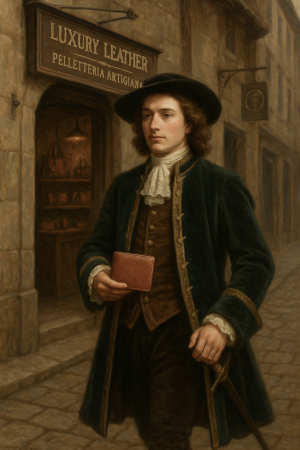Artisanal Leathercraft: The Living Art of Leather
Leather has always told stories. Long before we wrote on parchment, we treated it with care and respect. It was a shield, clothing, protection. Today, artisanal leathercraft still holds onto that ancient knowledge, shaped by skilled hands, patience, and a living material.
A Gesture Through the Centuries
In Italian workshops, often hidden down narrow alleys or behind stone doors, time seems to slow down. The sound of the mallet, the scent of tannins, the precision of the cut: every movement feels like a ritual. Handcrafted leatherwork isn’t just a technique. It’s a mindset, a cultural act passed down through generations of artisans.
Traces of leather objects have been found in Etruscan tombs, Roman mosaics, and medieval manuscripts. But it was between the Renaissance and the 19th century that Italian workshops began to mark their work with quality. During this time, the first leather schools were founded, tools were refined, and secrets were handed down from father to son.
The Heart of Tradition: Vegetable Tanning
No rush. Just bark, water, and weeks of waiting. Vegetable tanning is the oldest method of transforming rawhide into leather that’s strong, warm, and fragrant. The result? Leather that breathes, evolves with you, takes on sun and time. And gets better with age.
This process, still practiced today in Tuscany’s tanning districts, is not only sustainable but also ensures every piece is unique. The intense scent of freshly tanned leather, the way the color changes over time, the natural feel to the touch, all tell a different story than anything mass-produced.
Leather as a Living Material
No two hides are the same. Some show light scars, others bold grain patterns. Artisans don’t hide these details. They highlight them. Because leather is never neutral. It carries the traces of a life once lived, of lands walked, of past seasons.
The cut follows those lines. It’s a gesture that listens. Dyeing, often done by hand with natural pigments, is carried out in multiple steps, so the color soaks in while preserving depth and nuance. Stitching, done with a double needle and waxed thread, holds together not just the leather’s edges, but also the maker’s intent.
Italian Leather: Recognized, Desired, Imitated
From Tuscany to Veneto to Campania, the reputation of Italian leather is one of excellence. In Florence, the capital of craftsmanship, leatherwork is part of the cultural landscape. But Arzignano, Solofra, and Santa Croce sull’Arno also host tanning districts where tradition meets innovation.
The world’s top luxury houses source their leather from these places. Yet the true wealth lies in the small workshops, the independent brands, the one-of-a-kind products. Where quality isn’t a slogan. It’s a way of working, every single day.
When Leather Becomes Memory
A wallet that lasts ten years. A bag that ages with its owner. A belt that smells of leather and wood. Handcrafted leather goods aren’t disposable, they’re passed on. They become part of someone’s story, day after day.
Every scratch, every crease, every shade is shaped by time. Just like an old typewriter holds the rhythm of its typist, a leather satchel holds the habits of its owner. That’s what makes Italian artisanal leather more than just a product category. It’s living, everyday culture.
Menu
